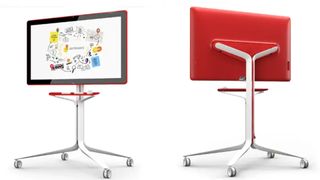What is Google Jamboard?
Google Jamboard is an innovative tool that allows teachers to interact with students with a whiteboard-style experience, only digitally without being in the same room. It's essentially a giant digital whiteboard that can be used by any teacher for any subject, making it a great tool for schools to use right across the -- ahem -- board.
Jokes aside, Jamboard does mean the hardware investment must be made for the full 55-inch 4K touchscreen experience. This offers 16 simultaneous points of touch contact and WiFi connectivity, plus handwriting and shape recognition. A Full HD webcam and two styluses are available, with an optional rolling stand that ideal for moving between classrooms.
However, Jamboard also works digitally as an app so it can be used on tablets, phones, and other devices. It'll even work via the web using Google Drive so it is really widely accessible. Of course, it also runs on Chromebooks, albeit without the shape or stylus support, but it's still a very capable presentation platform.
While Jamboard was designed with business use in mind, with a presentation kind of feel, it has been adapted widely and works well as a teaching tool. Lots of apps work with the platform, from Screencastify to EquatIO. So it need not be a from-scratch creative effort.
Read on to find out how to get the best out of the Google Jamboard app.

How to Use Google Jamboard
At its most basic, Jamboard is a great way to work through information with a class. This can be done remotely using the app, and could even be used with multiple devices to also incorporate Google Meet, as if you were all in the room together.
Of course Google Jamboard is also a great tool for integrating with Google Classroom since it is able to utilize Google Drive materials that are likely already being used by those who work with Classroom.
To access Jamboard, simply sign into your Google account, or sign-up for free. Then, when in Google Drive select the "+" icon and go down to "More" at the bottom, then down to select "Google Jamboard."
Alternatively you can download the app for iOS, Android, or using the Jamboard web app. Create a Jam and add up to 20 pages per Jam that can be shared with up to 50 students at once in real time.
Jamboard works with many apps, a process called app smashing. Here are some great examples that can help make teaching more engaging.
Get the latest edtech news delivered to your inbox here:

How to Create a Jam

To create a new Jam, find your way into the Jamboard app online, via the app, or using the physical Jamboard hardware.
In the board hardware, you simply need to tap the display when in screensaver mode to create a new Jam.
For mobile users, open the app and tap the "+" to get a new Jam started.
When using the web-based online platform, open the Jamboard program and you'll see a "+" which can be selected to get your new Jam up and running.
Your Jam will automatically save to your account, and can be edited as needed.
Getting Started with Google Jamboard
As a teacher using Jamboard it's good to start by being open and being ready to take a risk. This is a new technology that allows you to be creative and to try new things.
Let the class know you're trying something new, that you're vulnerable but you're doing it anyway. Lead by example so they feel they too can express themselves even when it may feel uncomfortable or they risk failure. That's the next tip: Don't be afraid to get it wrong!
Share what you're doing with Google Classroom – more on that below – so that even children away from class that day will be able to see what they missed.
When working in groups be sure to label each frame so that students can refer back and easily find the page they're working on.
Top Tips for Easier Jamboard Use in Class
Using the Jamboard is relatively simple but there are lots of shortcuts available to help make it more interesting and engaging for students.
Here are some useful tips:
- Use pinch to zoom to make pictures larger to quickly zoom in.
- When searching for an image, look for "GIF" to get moving images that kids love.
- Use handwriting recognition to input rather than keyboard for speed.
- If another teacher accidentally shares to your board, double tap the power button to cut it off.
- Use the palm of your hand to quickly erase anything on the Jamboard.
- Use Auto Draw, which will take your attempts at doodles and make them look better.
Google Jamboard and Google Classroom
Google Jamboard is part of the G Suite of apps so it integrates nicely with Google Classroom.
Teachers can share a Jam as an assignment in Classroom, allowing students to view, collaborate, or independently work on it as with any other Google file.
For example, create an assignment in Classroom, attach a math lesson Jam file as "Make a copy for each student." Google does the rest. You can also select "Students can view," which allows read-only access to a single Jam, if that's the way you need to work.
Google Jamboard and Screencastify
Screencastify is a Chrome extension available from the Chrome Web Store that can be used to record teachers using video. This is a great way to walk through a presentation, such as solving an equation, so the kids get the experience as if the teacher is really there by the whiteboard.
An easy way to use this is to create a new Jam as a whiteboard with a notebook or graph-style background. Then write out math problems to be worked through on each separate page. Screencastify can then be used to record and attach that video to each separate page. This means the students have a specific guide video for each separate problem you present.
Google Jamboard with EquatIO
If you go into Texthelp in the Chrome Web Store you can get the extension EquatIO to use with Jamboard. That is an ideal way for math and physics teachers to interact with the class.
Create a Google Doc and name it after a lesson or book chapter. Then use EquatIO to create math problems and insert each into the Google Doc as an image. Then all you need to do is copy and paste the images into page on a Jam and you've got yourself a digital worksheet.

